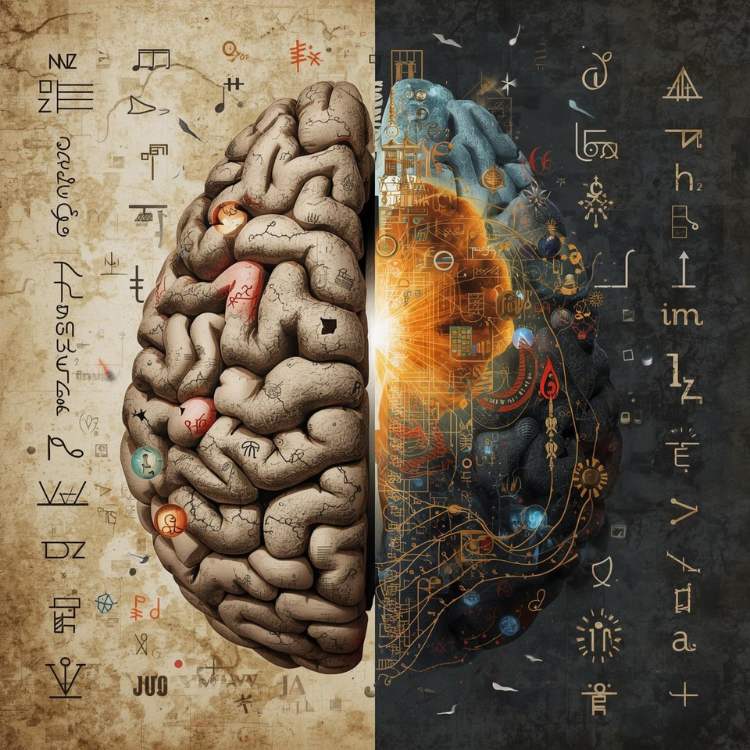
The Evolution of Culture: How Humans Transformed Biological Adaptation into Symbolic Adaptation 🧠🌍
What makes humans truly unique?
It’s not our strength, speed, or even intelligence alone — it’s our ability to create and live within culture.
From the first cave paintings to modern cities, humans have evolved far beyond mere biological survival. While early species adapted through genetic changes, Homo sapiens learned to adapt through *symbols, language, and shared meaning.
This transformation — from biological adaptation to symbolic adaptation — is one of the most fascinating revolutions in human evolution. It explains how humans became the only species capable of building civilizations, writing poetry, believing in gods, and shaping the planet itself.
Let’s explore how culture evolved, why it became our main tool for survival, and how symbolic thought continues to define what it means to be human.
What Is Culture? Understanding Humanity’s Greatest Invention 🧩
In anthropology, culture refers to the shared beliefs, behaviors, values, and knowledge that people pass from one generation to another — not through genes, but through learning.
Culture includes everything from language, art, and religion to tools, traditions, and moral systems. Unlike instincts, which are biologically inherited, cultural traits are transmitted socially — through imitation, teaching, and communication.
In simple terms:
Biological adaptation is about changing our genes.
Cultural adaptation is about changing our minds.
This ability to learn and transmit information made humans the most adaptable species on Earth, able to thrive in deserts, forests, ice fields, and skyscrapers alike.
Biological Adaptation: Nature’s Way of Survival 🧬
Before humans developed culture, all species — including our ancestors — depended on biological adaptation.
Biological adaptation occurs through natural selection: over generations, traits that help survival become more common in a population. Giraffes developed long necks to reach food; polar bears grew thick fur to survive the cold.
Early hominins, like Australopithecus, also adapted biologically:
- They evolved bipedalism (walking on two legs) to move efficiently on land.
- They developed opposable thumbs, allowing them to grasp and use tools.
- Their brain size increased, giving them better problem-solving skills.
But biology evolves slowly — over thousands or millions of years. Humans, on the other hand, discovered a faster, more flexible way to adapt: through culture.
The Cultural Revolution: When Learning Replaced Instinct 🔥
The turning point in human evolution came when our ancestors learned that knowledge could be shared.
Instead of waiting for genes to change, they began to transmit skills and information socially. The first sparks of symbolic behavior — communication, cooperation, and creativity — started to appear.
Some key moments in this transition:
Toolmaking (2.6 million years ago)
Homo habilis, known as “the handy man,” used sharp stone tools to cut meat and process plants. This marked the beginning of technological culture — learned behavior that could be passed on.
🔥 Fire Control (around 1 million years ago)
Homo erectus learned to control fire, which allowed cooking, warmth, and protection. Fire also encouraged social gathering, helping shape early communities and cooperation.
🗣️ The Birth of Language
Language was perhaps the most revolutionary step. It allowed humans not only to share information but also to create meaning — to plan, imagine, and remember.
With language, humans entered the symbolic world: they could name things, tell stories, and transmit ideas beyond immediate experience.
From Instinct to Imagination: The Rise of Symbolic Thinking 🎨
Symbolic thinking means the ability to let one thing — a sound, gesture, or image — represent something else.
This ability gave rise to:
- Art and ritual – Cave paintings, body decorations, and burial practices showed abstract thought and spirituality.
- Religion and myth – Humans began to create narratives to explain life, death, and the universe.
- Social identity – Symbols like clothing, ornaments, or tattoos began to express belonging and status.
Archaeological evidence from sites like Lascaux (France) and Blombos Cave (South Africa) reveals that symbolic behavior existed tens of thousands of years ago — long before written language.
This transformation marks the true beginning of culture as symbolic adaptation — humans no longer depended solely on the environment to survive; they transformed their environment through meaning.
Culture as a New Type of Adaptation 🧠
When humans began to rely on symbols, they unlocked a new evolutionary mechanism — one not driven by genes but by information and communication.
Unlike biological evolution, which is slow, cultural evolution is incredibly fast.
A new tool, belief, or custom can spread in just one generation.
Examples of symbolic adaptation:
- Clothing and shelter – Humans learned to build protection instead of growing fur.
- Medicine and hygiene – Cultural knowledge replaced genetic resistance.
- Agriculture – Instead of migrating to find food, humans learned to produce it.
Cultural innovation allowed humans to modify the environment instead of adapting biologically to it.
In short:
Animals adapt to their world.
Humans adapt their world to themselves.
The Social Brain: Why Cooperation Became Our Superpower 🤝
Anthropologists and neuroscientists often emphasize that human intelligence is deeply social.
Our ancestors survived not by being the strongest, but by being the most collaborative. Culture allowed people to work together, share tasks, and build complex societies.
Some key cultural behaviors that reinforced human survival:
- Food sharing – Encouraged cooperation and trust.
- Division of labor – Allowed specialization (hunters, gatherers, toolmakers).
- Storytelling – Passed knowledge and moral lessons across generations.
- Teaching – Ensured that skills and traditions didn’t die with one person.
This collective intelligence — powered by symbolic communication — became the foundation of human civilization.
Language: The Heart of Symbolic Adaptation 🗣️✨
Language is the cornerstone of human culture.
It’s not just a tool for communication — it’s how we think, organize, and understand the world.
Through language, humans can:
- Describe things that aren’t present.
- Imagine future scenarios.
- Express emotions, beliefs, and laws.
- Build shared realities — from religions to nations.
Linguist Noam Chomsky argued that language marks a biological revolution — a mental leap that made symbolic thought possible.
Once humans could use words as symbols, they could construct entire systems of meaning, leading to art, science, and morality
Culture and Evolution: A Two-Way Relationship 🔄
Culture and biology did not evolve separately — they co-evolved.
Cultural practices often influenced biological evolution. For example:
- The invention of cooking led to smaller jaws and larger brains.
- Agriculture and dairy farming favored lactose tolerance in some populations.
- Social living promoted the evolution of empathy and cooperation.
This dynamic feedback between genes and culture — known as gene-culture coevolution — shows that human evolution didn’t stop with biology. Culture became a powerful evolutionary force in its own right.
The Expansion of Symbolic Worlds: Religion, Art, and Science 🎭📚🔬
As symbolic thought developed, humans began to build complex systems of shared meaning — forming the foundations of modern societies.
🎭 Religion
Religion emerged as a way to give meaning to existence and strengthen social bonds. Rituals and myths created moral order and cooperation within groups.
🎨 Art
Art allowed humans to express emotions, identity, and imagination. From prehistoric paintings to digital art, creative expression remains a universal form of symbolic adaptation.
🔬 Science
Science represents the rational dimension of symbolic culture — humans using observation and logic to understand natural laws and improve life conditions.
These symbolic systems show how humans replaced purely instinctual responses with creative, abstract, and moral choices.
Modern Culture: The Acceleration of Symbolic Adaptation 🌐
Today, symbolic adaptation has reached unprecedented levels.
Technology, the internet, and global communication have transformed how we share knowledge and meaning.
- Digital symbols (emojis, memes, hashtags) have become new forms of language.
- Virtual communities connect people across the planet.
- Artificial intelligence and biotechnology are redefining what it means to be human.
While biological evolution takes millennia, cultural change now happens in real time. Our symbols evolve as fast as our imagination.
But this progress comes with new challenges — such as cultural fragmentation, misinformation, and the ethical dilemmas of technology.
Still, the ability to create and reinterpret symbols remains the essence of our humanity.
Conclusion: The Human Journey from Genes to Meaning 🌅
The story of human evolution is not just the story of bones and tools — it’s the story of ideas, imagination, and shared meaning.
By turning biological adaptation into symbolic adaptation, humans transcended the limits of nature.
We became the species that dreams, plans, and transforms — the only beings who can envision worlds that don’t yet exist.
Culture is not a luxury; it’s our most powerful survival strategy. It allows us to face change, overcome crises, and build connections beyond time and space.
In the end, what defines us is not what we are, but what we mean.
And as long as humans continue to think, speak, and create, our symbolic evolution will never stop. 🌍✨
Sources
- Boyd, R. & Richerson, P. (2005). The Origin and Evolution of Cultures.
- Tomasello, M. (2014). A Natural History of Human Thinking.
- Dunbar, R. (1998). The Social Brain Hypothesis.
- Geertz, C. (1973). The Interpretation of Cultures.
- Wrangham, R. (2009). Catching Fire: How Cooking Made Us Human.
- Smithsonian National Museum of Natural History (Human Origins Program)
- UNESCO: Culture and Sustainable Development Reports (2023)

